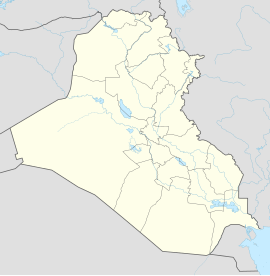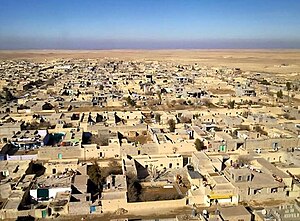Khana Sor
| Khana Sor | ||
|---|---|---|
| location | ||
|
|
||
| Coordinates | 36 ° 28 ′ N , 41 ° 37 ′ E | |
| Country |
|
|
| Governorate | Ninawa | |
| District | Sinjar | |
| Basic data | ||
| height | 500 m | |
| Residents | 31,161 (July 2014) | |
| View of the city of Khana Sor | ||
Khana Sor (also Khanasor , Kurmanji Xanasor, Arabic خانصورTo German " red house ", even al-Tam'eem ) is a small, of Yazidis inhabited city in the north of Iraq . The city is located in the Sinjar district north of the Jabal Sinjar in the Ninawa governorate . The place is one of the disputed areas of Northern Iraq .
history
Khana Sor is a so-called "model village" (also called muǧammaʿāt) and was founded between 1965 and the 1970s. For the settlement of the Yazidis other Yazidi villages were depopulated. In 1965, the then Iraqi government decided to destroy the Yazidi villages of Jabal Sinjar and to force the residents to relocate. The 400 or so Yazidi villages of Jebel Sinjar were partially bulldozed and the residents were driven out. The Ba'ath regime called these forced resettlement measures modernization projects.
Like the entire Sinjar region and the entire Ninawa province, Khana Sor has been one of the disputed areas of northern Iraq since the fall of Saddam Hussein in 2003 . The city was controlled by Kurdish Perschmerga until August 2014 .
In August 2014, the city was attacked by the Islamic State and brought under their control. ISIS was later driven out of the city and the entire Sinjar region and the place is considered liberated and recaptured. Even so, few residents have returned to the city.
The city is currently controlled by the Iraqi army . In March 2017 there was an armed conflict between Kurdish and Yazidi armed forces, with German weapons also being used by the Kurdish armed forces against the Yazidi armed forces.
population
The population of Khana Sor only includes Yazidis . As a result of the genocide of the Yazidis in 2014, these were abducted, murdered or expelled by IS . Many of the city's residents are currently living in refugee camps in the Kurdistan Autonomous Region .
See also
Individual evidence
- ^ Emerging Land Tenure Issues among Displaced Yazidis from Sinjar, Iraq. (PDF) In: United Nations Human Settlements Program (UN – Habitat). November 2015, accessed December 5, 2018 .
- ↑ a b Hope in ruins . ( tagesspiegel.de [accessed November 30, 2018]).
- ^ A b Otmar Oehring: Christians and Yazidis in Iraq: Current Situation and Perspectives. In: Konrad Adenauer Foundation. P. 92 , accessed November 30, 2018 .
- ↑ Irene Dulz: The Yezidis in Iraq: between "model village" and escape . LIT Verlag Münster, 2001, ISBN 978-3-8258-5704-2 , p. 54–55 ( google.de [accessed February 27, 2019]).
- ^ Human Rights Watch. Retrieved November 30, 2018 .
- ↑ a b Elke Dangeleit: Northern Iraq: Yazidis fear expulsions again. Accessed November 30, 2018 (German).
- ↑ Sinjar Mountains in Northern Iraq - Hesitant return of the Yazidis . In: Deutschlandfunk . ( deutschlandfunk.de [accessed November 30, 2018]).
- ↑ EpochTimes.de: Iraqi army discovers Yazidi mass grave in Sinjar region . In: Epoch Times www.epochtimes.de . November 22, 2017 ( epochtimes.de [accessed November 30, 2018]).
- ↑ SPIEGEL ONLINE, Hamburg, Germany: Iraq: Kurdish militia is apparently fighting against Yazidis with German weapons - SPIEGEL ONLINE. Retrieved November 30, 2018 .

